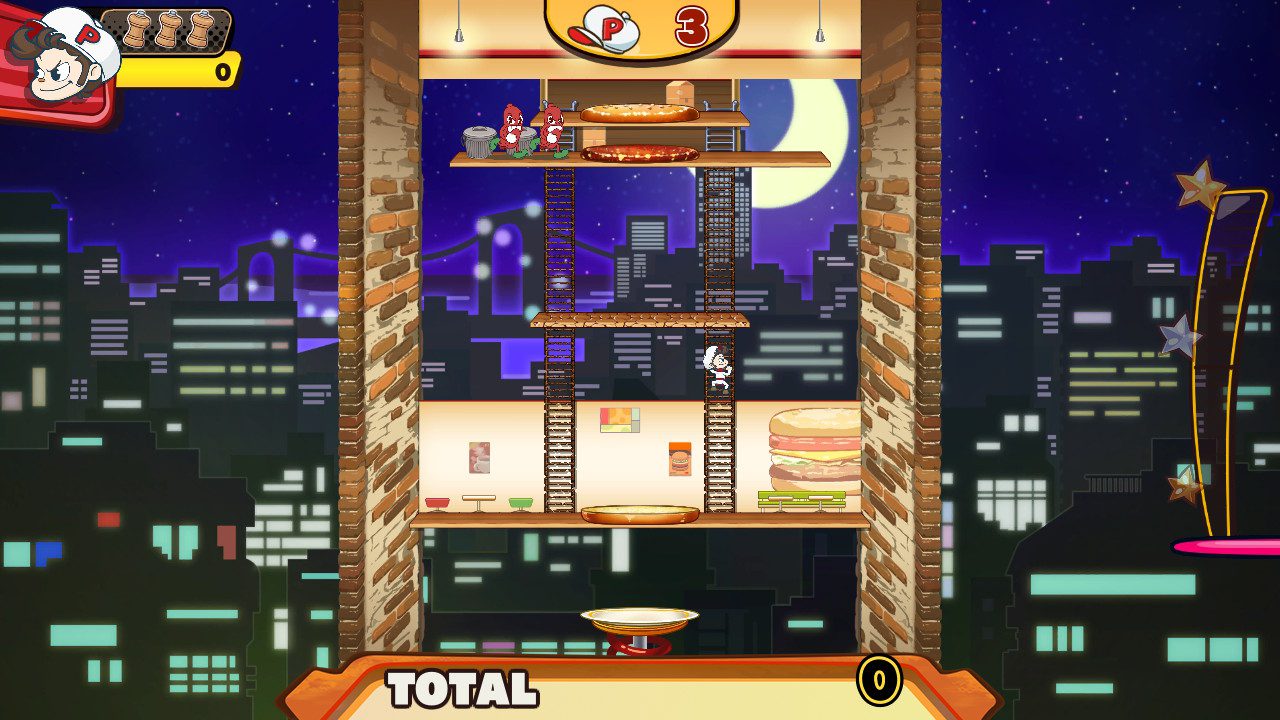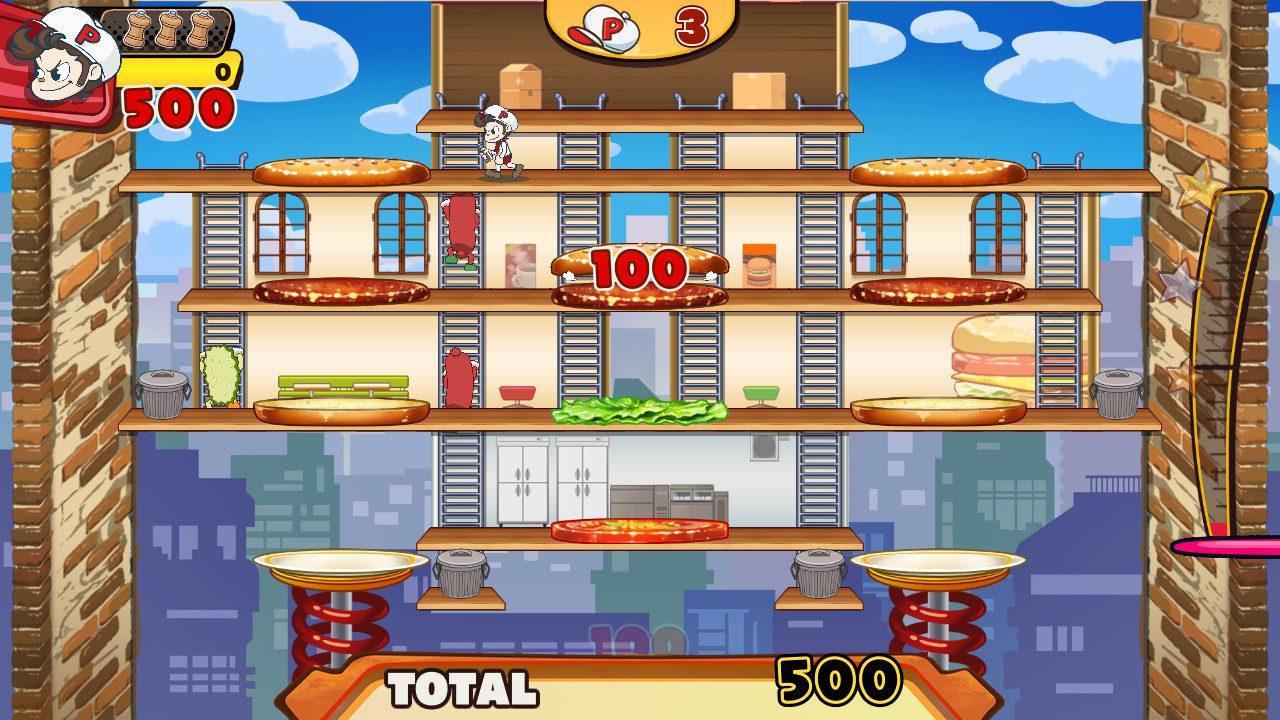As of late, it seems old Data East properties have made a resurgence with several titles making a comeback in many different forms. Retro-Bit released their Data East All-Star Collection, an officially licensed NES 5-in-1 multi-cart. My Arcade released the Data East Mini Player, which contains 35 Data East titles. Japanese company G-Mode acquired most of Data East’s back catalog in 2004. As a result, the properties are licensed out and 3rd party devices can be made. While these devices are a great way for them to redistribute many classics, most of these IPs haven’t seen a new entry in decades. One series that seems to have found its way out of purgatory is Burger Time. Teaming up with publisher Xseed Games, G-Mode released Burger Time Party! on October 1st 2019; acting as a soft reboot to the series.
If you’ve ever played a Burger Time game before, Burger Time Party! will feel right at home. Your primary attack is flicking a pinch of pepper in whatever direction being faced. This is done using either the A, B, X, or Y button. Movement is controlled exclusively using the left analog stick. Right off the bat, it bothers me that you can’t control the main character, Peter Pepper, using the control buttons/D-Pad. It’s a shame, as this would have been a great game to test out my new Switch Lite’s D-Pad. The controls feel nice and responsive though, incredibly familiar for those with history with original.
The basic premise to Burger Time Party! is to build cheeseburgers by walking over the parts of the sandwich strewn throughout the level. This will cause the patty, condiment, and/or bun, to slide down a level. The ultimate goal is to complete the burger, by sliding everything down to the level furthest down. This is made difficult by the various walking foods that must be avoided to survive. While knocking down the ingredients can be done with relative ease, attempting to get a high score will prove more difficult. Lining up enemies on an ingredient and sending them down a level will net way more points. Various power-ups and items spawn at random, which vary from simple point boosters to food items that either slow down or stop enemies in their path or grant Peter temporary invincibility.
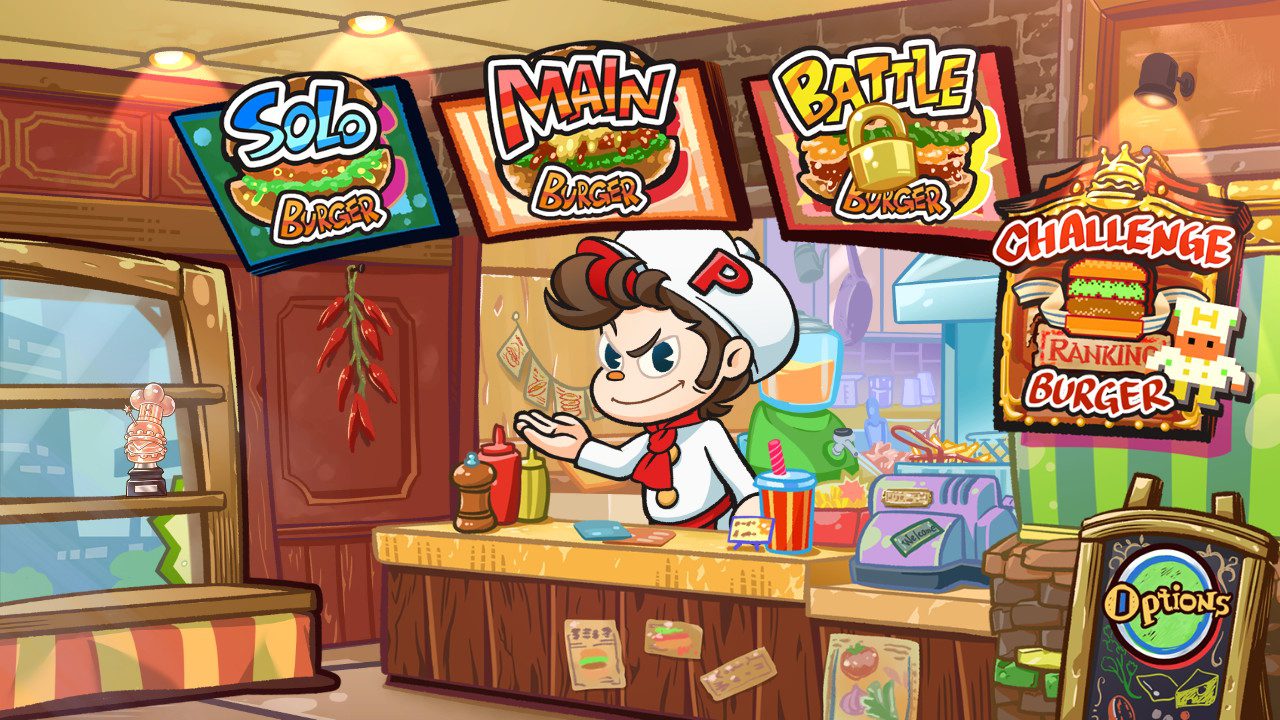
While the game plays similarly to its arcade and NES counterparts, Burger Time Party! offers many new modes. “Solo Burger” is the first mode available, with others unlocking as the player progresses. This mode acts as a single-player tutorial for gameplay, as well as easing players into some more difficult stages, as well as show them how to pull off combinations with the enemies.
“Main Burger” is a 1-4 player experience similar to “Solo Burger”, featuring larger stages with bigger challenges, as well as cooperative support. This mode sometimes felt too big, making the playing field difficult to see. This could be due to the incredibly simplistic art style. This wasn’t as big of an issue playing on a television with my other Switch console, however, it’s a glaring issue while in portable mode.
“Battle Burger” is a 2-4 player multiplayer exclusive mode that has players divided between being a color variant of Peter Pepper or one of the walking food enemies. The goal of the players using Peter Peppers is to try and clear all burger lines, while the enemy players must try to knock out all of the Peters. Players using Peter can revive other players by walking over them, while enemy players will auto-revive after a period short time. This mode is incredibly fun to play with friends.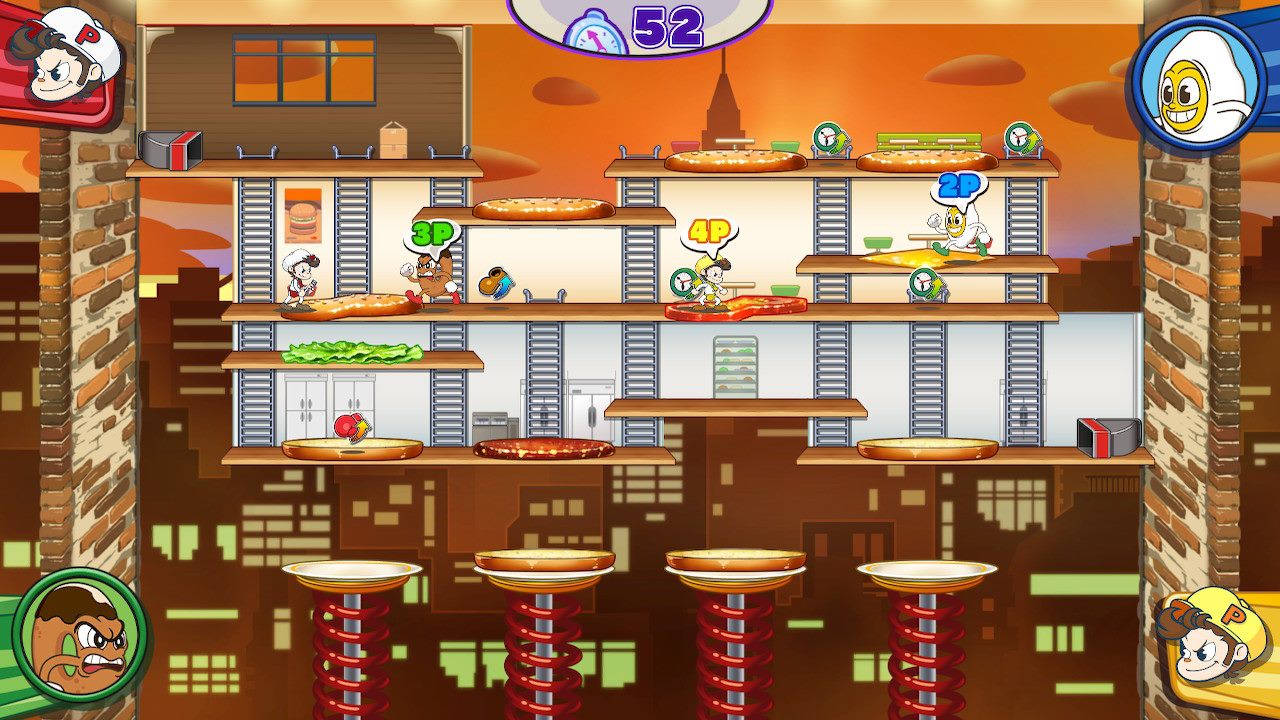
“Challenge Burger” is the final mode offered, which allows 1-4 players to take on challenges to compete for the high score on an online leaderboard. This mode offers many sub-modes, including “Easy”, “Medium”, and “Hard” stages as well as “Classic”, which includes remade stages from past Burger Time games. Playing “Classic” was my favorite, as seeing essentially the original game remade in HD was a treat and a good addition to the overall package.
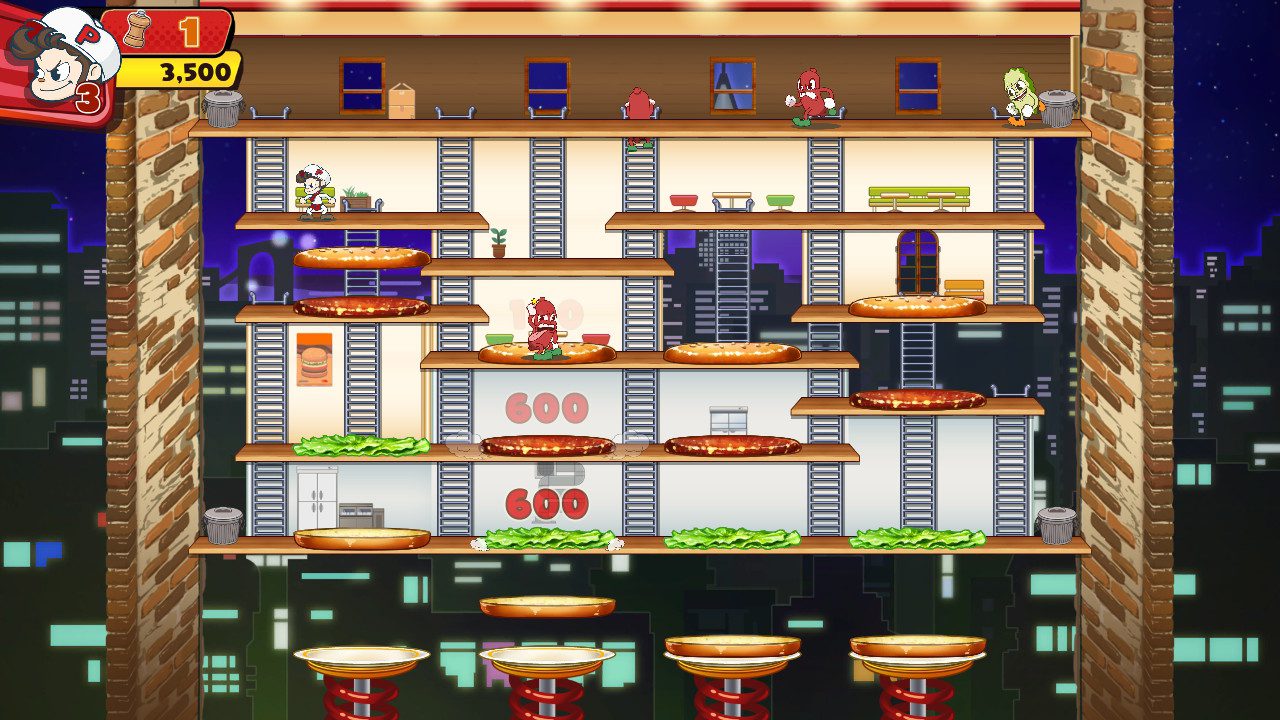 Burger Time Party! attempts to recreate that classic cartoon art style. It’s reminiscent of the Bob’s Big Boy restaurant chain, or Studio MDHR’s 2017 indie darling, Cuphead. Burger Time Party! fails with its presentation, however, as it comes off as generic. The enemy characters have a little attitude in their movement; however, Peter Pepper is an incredibly standard looking young chef who lacks personality. The menu system is equally, if not more, bland. They honestly look like they were pulled from an early 2010 mobile game. It’s also frustrating that the menus don’t have touch screen support. That’s obviously not an issue for docked play but it’s still something that felt like it should have been added.
Burger Time Party! attempts to recreate that classic cartoon art style. It’s reminiscent of the Bob’s Big Boy restaurant chain, or Studio MDHR’s 2017 indie darling, Cuphead. Burger Time Party! fails with its presentation, however, as it comes off as generic. The enemy characters have a little attitude in their movement; however, Peter Pepper is an incredibly standard looking young chef who lacks personality. The menu system is equally, if not more, bland. They honestly look like they were pulled from an early 2010 mobile game. It’s also frustrating that the menus don’t have touch screen support. That’s obviously not an issue for docked play but it’s still something that felt like it should have been added.
While the art style was a letdown, Burger Time Party! earns some points with its soundtrack. The music is catchy, and has a familiar vibe to it, while still feeling fresh. More disappointment pursued though as there is a lack of diversity. Due to the music’s enjoyability, this can slightly be omitted. The game’s sound effects are nothing to write home about. Much like the graphics, the effects department felt stale. With a little more effort in development, I feel like these are issues that could have easily been fixed.
All things considered, Burger Time Party! is a blast! The single-player modes offer familiar gameplay to previous entries in the series, while offering a modern twist and slightly tweaked controls. The multiplayer modes take the original formula and create a uniquely fun experience, which can be played both cooperatively and competitively. The most glaring issue Burger Time Party! is plagued by is its uninspired presentation. Hidden within its generic budget-title-like appearance is an exciting arcade-like experience.
If you can look past the ugly artwork, you’ll find it really is a good game with hours of fun!
Burger Time Party! is available now exclusively on the Nintendo Switch for $29.99. For more information on Burger Time Party! and to purchase it digitally, visit the official eShop page. More information can also be found on developer G-Mode’s official website. A digital copy of the game was provided for the purpose of review.

